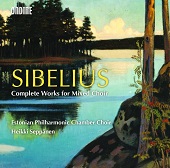Tuesday, November 17, 2015
Sibelius at 150 (Part 2): The Choral Music
Ondine ODE 1260-2D (2015)
Sibelius: Complete Works for Mixed Chorus
Heikki Seppanen/Estonian Philharmonic Chamber Choir
Released in the spring of 2015 in anticipation of the 150th anniversary of the composer’s birth on December 8th, this 2-disc set from the Finnish label Ondine features fine performances by the Estonian Philharmonic Chamber Choir under Heikki Seppanen in beautiful, up-to-date recorded sound. The album is packaged in a handsomely lithographed slipcase, accommodating a standard-width gate-folding jewel case, and a glossy 60-page booklet with complete texts including English translations, and an extended historical/biographical essay by Sakari Ylivuori.
Choral music was, more or less, a sideline for Sibelius, and this rather eclectic assemblage of music doesn’t represent a coherent “body of work” in the unmistakable way the symphonies and tone poems do. In any case, listeners expecting the same level of striking originality and formal innovation are bound to come away disappointed. What one gets here is, for the most part, a diverse mish-mosh of un-opused odds and ends, small-scale works commissioned for special occasions and events, a few tantalizingly brief pieces hardly more than gnomic fragments, with, here and there, the inspired curiosity. Throughout, one is struck by the fact that Sibelius’ most original and stylistically adventuresome contributions to the a cappella choral repertory were made in the early part of his career, before the turn of the 20th century, not, as one might expect, in the 1910s around the time of the 4th and 5th symphonies and the striking cantata for chorus and orchestra My Own Land Op. 92 from 1919, or the autumnal 1920s with awe-inspiring works such as the 7th Symphony, Tapiola and the incidental music for The Tempest.
The collection is book-ended by two of the composer’s “greatest hits”, Rakastava (The Lover) from 1893-98 at the beginning of the first disc, and, at the end of the second, two different choral versions of Finlandia from Opus 26 of 1899, in F major and A-flat major, both arranged in 1948. In between, listeners are treated to fascinating rarities like the Three Songs for American Schools from 1913—setting of English texts no less!— a charming trio of Christmas songs—surprisingly conservative for having been composed in the late 1920s—and three different arrangements of the tunefully Brahms-ian sarcred triptych Carminalia from 1898.
Language may, indeed, be a barrier to appreciation—though I think one could argue that a poor performance of a work in any language is just as daunting an obstacle. Badly enunciated English spoils Holst and Britten no more for an Anglophone than an unfamiliarity with German or Danish throws up a scrim in front of Brahms or Nielsen. Far more instructive and rewarding is a consideration of this repertory in the context of its musical time and stylistic milieu. One may discern the influences of Brahms and Bruckner, note stylistic or tonal similarities to contemporaries like Reger and Nielsen, or remark foreshadowings of the youthful Bartok.
I have yet to hear the recordings of this same repertory from the 2011 Sibelius Edition on Bis (Vol. 11 in the 13-album series), which presents the music in chronological order of composition, an arrangement that might well have benefited the Ondine program. I have had the opportunity to compare some of the alternate arrangements for chorus and orchestra (Sibelius Edition Vol. 3), as well as versions for male chorus performed by the magnificent YL Ensemble (The Voice of Sibelius (BIS CD-1433 (2008)). By and large I find the BIS performances more nuanced and subtle--listen especially to YL's magical reading of Raakastava-- and would highly recommend this latter disc as a companion to the Ondine album.
Subscribe to:
Post Comments (Atom)


No comments:
Post a Comment